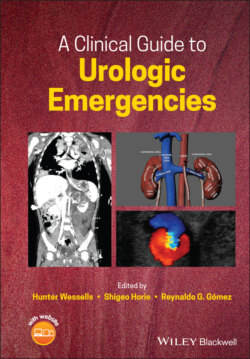Читать книгу A Clinical Guide to Urologic Emergencies - Группа авторов - Страница 18
Radiographic Evaluation
ОглавлениеThe American Urological Association (AUA) has released guidelines to provide indications for imaging of suspected renal trauma [34]. Patients sustaining blunt injury that require diagnostic imaging are those who have gross hematuria, or those who have a systolic blood pressure of less than 90 mmHg with microscopic hematuria. Additionally, any patients who are stable but have a mechanism of injury (e.g. fall from a great height) or physical examination (see above) findings concerning renal injury should also be imaged, as trauma patients may have renal injury, even in the absence of hematuria or shock [14, 35]. Based on the AUA Urotrauma Guidelines, children should be imaged with the same modality and criteria as adults.
If imaging is obtained, a contrast enhanced CT (computed tomography) abdomen pelvis with immediate and delayed images is recommended, in order to visualize the kidney parenchyma and collecting system and to look for evidence of bleeding or urinary extravasation. The immediate phase is typically an arterial or early venous phase, which highlights the renal parenchyma and can be useful for evaluating for parenchymal laceration, intravascular contrast extravasation, and hematoma. The delayed phase, typically obtained at 10–15 minutes after contrast administration, is useful to evaluate the collecting system of the kidney and the ureter. In addition, subtle findings on initial venous imaging such as perinephric stranding, hematoma, and low‐density retroperitoneal fluid may prompt imaging with delayed phase to evaluate for a ureteropelvic or ureteral injury; a large medial urinoma or contrast extravasation on delayed images without distal ureteral contrast visualized is concerning for a renal pelvis or ureteral avulsion injury [36, 37].
Evaluating the size of a perinephric hematoma, the presence of intravascular contrast extravasation, and a medial laceration on CT can be useful, as these factors can predict bleeding complications and help guide management, as discussed in the management section (below).
Renal injuries are classified by the Organ Injury Scaling of the American Association for Surgery of Trauma (AAST) [38] (Table 1.2, Figures 1.1 and 1.2). Grade I injuries are renal contusions or subcapsular hematomas without parenchymal laceration. Grade II injuries involve perirenal hematomas of the renal retroperitoneum or parenchymal renal lacerations that extend for less than 1 cm. Once the laceration extends for greater than 1 cm into the renal parenchyma, this becomes a grade III injury, with an elevation to grade IV if there is collecting system involvement (i.e. urinary contrast extravasation from the renal collecting system). Grade IV injuries also include contained hilar vascular injuries, such as injury to the main renal artery or vein. Grade V injuries are so‐called “shattered” kidneys and renal hilar avulsion injuries that cause devascularization of the kidney. Revisions have been proposed to this classification in order to include previously undescribed injuries and reclassify other injuries to facilitate more appropriate alignment of classification and management/outcomes, particularly in order to better classify vascular (such as segmental vessel injury) and collecting system injuries, though these revisions have not been formally accepted [40–43].
Table 1.2 2018 American Association for the Surgery of Trauma (AAST) organ injury scale [38].
| Grade | Description of Injury |
|---|---|
| I | Subcapsular hematoma and/or parenchymal contusion without laceration |
| II | Perirenal hematoma confined to Gerota fascia Renal parenchymal laceration ≤1 cm depth without urinary extravasation |
| III | Renal parenchymal laceration >1.0 cm parenchymal depth without collecting system rupture or urinary extravasation Any injury in the presence of a kidney vascular injury or active bleeding contained within Gerota fascia |
| IV | Parenchymal laceration extending into urinary/collecting system with urinary extravasation Renal pelvic laceration and/or complete ureteropelvic disruption Segmental renal vein or artery injury Active bleeding beyond Gerota fascia into retroperitoneum or peritoneum Segmental or complete kidney infarction(s) due to vessel thrombosis without active bleeding |
| V | Main renal artery or vein laceration or avulsion of hilum Devascularized kidney with active bleeding Shattered kidney with loss of identifiable parenchymal renal anatomy |
Figure 1.1 American Association for the Surgery of Trauma (AAST) Organ Injury Severity Score for the Kidney.
Source: from Campbell‐Walsh, 10th Edition with permission [39].
Figure 1.2 CT images of renal injuries including: (a) axial view of a left subcapsular hematoma (AAST Grade I); (b) a large right perinephric hematoma and a 2‐cm parenchymal laceration (Grade III); (c) intravascular contrast extravasation into a right perinephric hematoma (Grade III); (d) coronal view of a left upper pole perfusion defect consistent with a segmental vascular injury (Grade IV); (e) a right medial parenchymal laceration with urinary contrast extravasation (Grade IV); and (f) a shattered left kidney with hematoma, contrast extravasation and multiple parenchymal fragments (Grade V).
Source: courtesy of Alex Skokan, MD.
If CT is not available, or if the patient is brought directly to the operating room for exploration without first obtaining imaging, and renal injury is suspected due to hematuria or a perinephric hematoma, a one‐shot intravenous pyelogram (IVP) can be useful, primarily to confirm the presence of a contralateral kidney, and secondarily to identify injury of the kidney of interest, although it is much less sensitive to detect injuries than CT (see image) [44]. A one‐shot IVP is obtained by administering 2 ml/kg IV bolus of contrast with a single x‐ray of the abdomen obtained 10–15 minutes later. The radiographic image quality can be limited by under‐resuscitation, hypotension, significant edema, or renal dysfunction. One study evaluated the quality and usefulness of one‐shot IVP in the operative setting, finding that the average quality score was 3.84/5 with only 1/50 studies found to be unintelligible, and the majority (66%) were good or of excellent quality. The average usefulness score was 3.96/5, with only 1 imaging study considered worthless and the majority (72%) considered important or critical for determining urological management.
Other imaging modalities such as ultrasound, radionucleotide scintigraphy, and angiography are not recommended for initial evaluation of renal injuries but may be useful during subsequent management.
